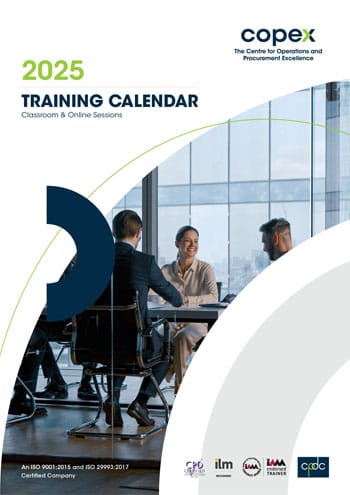
A Highly Interactive Training Course On
Financial Forecasting in a VUCA World
Sales, Valuation and Performance Forecasting Tools
Course Introduction
In today’s dynamic economy, characterized by volatility, uncertainty, complexity, and ambiguity (VUCA), financial forecasting has become increasingly challenging. Spreadsheet models have traditionally been the primary tool for finance professionals to apply their financial expertise. However, in the wake of recent financial crises, the demand for skilled Financial Modelling professionals has surged. Organizations now require robust planning and adaptive strategies to navigate and succeed in a VUCA world. This Financial Forecasting in a VUCA World Training Course will help participants recognise the purpose of Financial Modelling & Forecasting, and the challenges of the VUCA world.
This COPEX training course will feature:
- Financial Statement Modelling
- CAPEX
- DCF
- Sensitivity Analysis
- Scenario Analysis
Training Objectives
By the end of this training course, participants will be able to:
- Recognise the challenges of VUCA world
- Recognize the purpose of Financial Modelling and Forecasting
- Explain the key steps of Financial Modelling
- Forecast future firm’s performance and Valuation
- Use different planning tools: scenario and sensitivity analysis
Training Methodology
This training course will utilise a various of proven learning techniques to ensure maximum understanding, comprehension and retention of the information presented. This includes a presentation in a highly interactive manner, individual and group activities interspersed throughout the sessions, along with appropriate case studies and video documentaries that will highlight the significant teaching features.
Who should Attend?
This COPEX training course is suitable to a wide range of professionals but will greatly benefit:
- Finance Professionals across the organisation
- Head Office Planning Managers
- Budgeting and Forecasting Teams
- Commercial Managers
- Finance Strategic Business Partners
Course Outline
- The Imperatives of a VUCA World: a sound of Financial Modelling
- What is Financial Modelling?
- Defining the Inputs and the Outputs of a Simple Financial Model
- The Financial Modelling Process of More Complex Models
- Excel as a Tool of Modelling: Capabilities and Limitations
- How Financial Models Work
- Collecting and Analyzing Historical Data
- Selecting the Key Forecast Drivers
- Modelling the Income Statement
- Modelling the Balance Sheet
- Modelling Interest and Circular References
- Modelling the Cash Flow Statem
- Designing a Dashboard-like Control Panel
- Basic Statistical Methods Used for Forecasting
- Forecasting Sales: Bottom-up Versus Top-down Forecasting
- Forecasting Costs
- Forecasting CAPEX and Depreciation
- Forecasting Funding Needs
- Valuation Approaches
- Steps for Applying the DCF Method
- Rewriting Financial Statements – Calculation of Free Cash Flows
- Calculating the Weighted Average Cost of Capital
- Estimating the Terminal Value
- One-Dimensional and 2-Dimensional Sensitivity Analysis
- Choosing the Variables to Change
- Modelling Example
- Interpreting the Results
- Scenario Analysis Example
Providers and Associations


Certificates
- COPEX Certificate of Attendance will be provided to delegates who attend and complete the course
Material published by Copex shown here is copyrighted. All rights reserved. Any unauthorized copying, distribution, use, dissemination, downloading, storing (in any medium), transmission, reproduction or reliance in whole or any part of this course outline is prohibited and will constitute an infringement of copyright.
COPEX Training is your gateway to professional growth, with over 20 years of experience turning potential into success. Each year, we deliver over 1,000 courses in 50+ countries, earning a stellar 98% satisfaction rate. Trusted by global giants like BP, the United Nations, and HSBC, we partner with top certification bodies to provide career-focused training that empowers individuals and drives organizational breakthroughs. Our mission? To transform the way professionals learn and grow in today’s fast-changing industries. Through expert insights, cutting-edge methods, and hands-on approaches, we equip you with the skills and confidence to tackle challenges, seize opportunities, and thrive in your career.
Led by a passionate leadership team and supported by a network of world-class trainers, COPEX Training connects professionals worldwide with life-changing opportunities. We are committed to excellence, ensuring every participant leaves with the tools, expertise, and confidence to conquer an ever-evolving world.
Frequently Asked Questions
This FAQ section provides quick answers to the most common questions about our services, procedures, and policies. We aim to make your experience with us as straightforward as possible. For further assistance, our support team is ready to help.
Enhanced Skills: Develop in-demand skills and knowledge in your chosen field.
Career Advancement: Improve your career prospects and increase your earning potential.
Increased Confidence: Gain confidence in your abilities and enhance your professional presence.
Networking Opportunities: Connect with other professionals and industry experts.
Improved Job Performance: Enhance your productivity, efficiency, and job satisfaction.
Personal Growth: Develop valuable personal and professional skills that can benefit you in all areas of life.
Experienced Instructors: Courses are delivered by highly qualified and experienced instructors with industry expertise.
Interactive Learning: Engaging and interactive learning methods, including workshops, simulations, case studies, and group discussions.
Practical Application: Focus on practical skills and real-world applications, enabling you to apply your learning immediately.
Flexible Learning Options: A variety of course formats available, including classroom training, online courses, and blended learning.
Certification & Recognition: Upon successful completion, you may receive industry-recognized certifications.
There are several ways to register in our public training courses:
Online – Browse the Training Plan, select the course of choice, click on the button
“Register Now” inside the course outline page.
E-mail – Send the details (name, company name, email address and training course of
choice) of your nomination to [email protected]
Telephone – +971 4 368 6886 or +971 50 106 2750
Upon successful registration, processing window will take not more than 24 hours from the time of registration. An email including the registration confirmation, invoice and joining instructions will be sent to the provided email address.
Published training course fees are inclusive of the training venue, training manual, writing materials, lunch and coffee breaks with refreshments over the entire duration of the training course.
The training course fee can be settled by either:
- Bank transfer
- Credit Card
Our training courses will run for 5 hours per day. The standard daily timing is from 8:30 am – 3:30 pm including the coffee/tea breaks and lunch.
Our training courses courses are being held at five-star hotels in prime and iconic destinations across the globe. Cities such as Amsterdam, Barcelona, Dubai, Geneva, Istanbul, Kuala Lumpur, London, Houston, New York, Paris, Vienna, Zurich, etc.
Once officially registered, we can assist by providing the corporate rates provided by the hotel where the training course will be conducted. Early confirmation will enable us to secure the room at reduced rates
Our cancellation policy varies depending on the circumstances presented. Generally, cancellations must be initiated in formal writing at least 14 days prior to the commencement date of the training course. Further, the option to shift an existing registration to another training course on a later date is possible. Otherwise, a full refund will be initiated.
Delegates who will attend and successfully complete the training course will earn a COPEX Certificate of Completion. This certification is designed to validate the successful knowledge transfer, and that the desired learning objectives and outcomes to further advance your professional competency are achieved.

We can customize this
training course for you!
Other Specialized Training Courses
Explore a selection of specialized training courses designed to advance your skills and knowledge in key areas critical to professional success. COPEX provides a wide range of programs tailored to meet industry demands, empowering you to stay competitive in today’s dynamic landscape.

